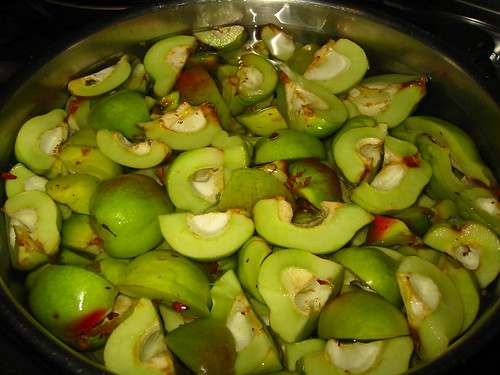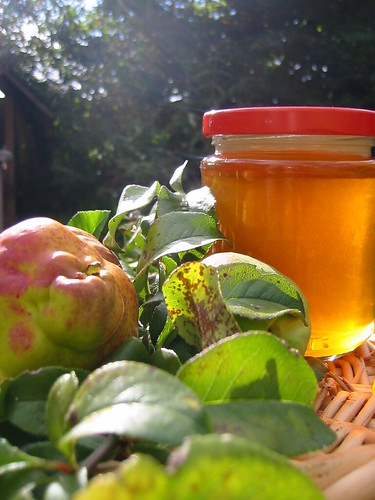Anyway, there's a lot about the genus at Wikipedia which looks good enough to me, explaining that the naming of the species and hybrids botanically is confused by the casual use of Japonica by gardeners to refer to just about any sort of Chaenomeles regardless of its actual identification. The Chaenomeles genus is NOT the same as the true quince, Cydonia and I suppose the common name arose to help with that differentiation as much as anything.
I don't even own a 'japanese quince', my fruit came from the branches of a plant that overhangs our garden fence. This bush is extremely vigorous and as well as threatening to swamp our greenhouse from above is sending suckers under the fence and up into the greenhouse from below. The thorns are extremely long and vicious making removal a dangerous task.
The fruit though, is fun. Absolutely vile to eat raw because it is so tart, it feels hard and unpromising but has a delicate aroma and a golden glow that encourages further investigation.
Cut them open and the plentiful seeds fall out from roomy seed cases that take up a large part of the centre of the quince. The flesh is jade in colour and slices easily into a large pan.

From this point it's much the same as making any other hard fruit jelly. Barely cover the prepared fruit with water and bring to a gentle simmer to soften the flesh and release the juice. Don't do as I did and allow the pan to boil over, I must have lost at least a pint of juice like that.
When the fruit is softened to a pulp, mash it a bit with a potato masher and strain the whole lot through a jelly bag for a few hours. Best not to squeeze for a beautiful clear jelly and this does make a wonderful glowing pot of loveliness.
Add a pound of sugar to each measured pint of juice, warm to dissolve the sugar and then boil briskly for 10 minutes or so. Something that surprised me was the frothiness of the boiling jelly, far more so than the apple juice I used earlier in the week. Skim off the scum as best you can. The jelly will set more quickly and more firmly than most as it has a lot of pectin in it.
Pot up in sterile jars and cover while hot. The jelly is still very sharp to my taste but refreshing and has a delicate flavour, which I think would take orange flavouring very well. It would be worth experimenting with the rind and juice of a couple of oranges in the next batch to make a Quince Marmalade, which might amuse the philologists among you. It looks beautiful.

4 comments:
Sounds cool, I'm going to give it a go this weekend. Ta for the recipe.
Sounds like you threw the best part away. The pulp can be used to make a paste (membrillo) which is truly wonderful, especially with Manchego cheese and is much nicer than the jelly.
No, Geexer, I don't think so. These are not true quince but a distant relative and although it would have been possible to seed the tiny fruit and thus have clean pulp to make sweets with it was a step too far for my convenience. We make a lot of fruit paste with the medlars anyway, which are sufficient for our needs in that regard.
Yes it is time consuming, no need to remove the seeds tho, and as Chaenomeles are more plentyfull for us than Cydonia, we will continue to use them for membrillo
Post a Comment